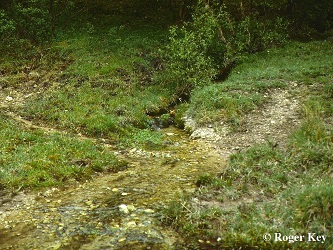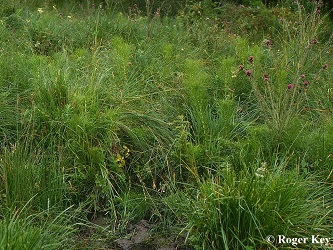Current ISIS code: W126
Previous assemblage name: None. It was established in 2008 as a cross-cutting assemblage.
Linked assemblage: Frequently present with F112 open short sward, although it can turn up in F111 bare sand & chalk, especially in brownfield areas.
Description of habitat typically supporting the assemblage: This wide ranging SAT occupies a range of seepage types from shaded seepages to open calcareous seepages. It is vulnerable to small scale pond creation operations, drainage and changes in rainfall patterns.
The assemblage type is found widely in Britain in association with groundwater sources. Assemblages in shaded seepages are dominated by crane flies and are especially species-rich in wet woodlands, especially in seepages under alder or willow (sallow) woodland in valley bottoms, and under birch or sometimes alder-ash woodland on hillsides. The soil is constantly saturated and usually contains a large proportion of organic matter giving rise to deep ooze. Vegetation diversity is often limited, although Carex paniculata may be well developed in some places. Dead wood is an important component of these seepages, as this is the medium for some crane fly larvae.

Assemblages in more open seepages are confined to limestone districts and to a lesser extent chalk.
Sometimes they can be found in base-rich seepages and springs arising from glacial clays and sands which are rich in calcium carbonate. Most calcareous seepages are small and very localised features, although large expanses are present in some upland areas such as the Pennines. As well as a high base status that gives rise to travertine deposits, the issuing water is also characterised by small temperature fluctuations and relatively low trophic status. Patches of short or open vegetation, often dominated by carpets of Cratoneuron mosses, are maintained by light grazing or, in the uplands, by exposure.

The fly larvae are aquatic or semi-aquatic and often found in the thin water film or within mosses. Most crane fly larvae are either predators or detritivores living submerged within the surface layer of shaded, saturated soil. The snails are found above the water but in damp tussocks. As seepages merge into runnels and small streams, elements of this assemblage type, for example Oxycera analis, occur in conjunction with flowing water assemblages. Some species, such as Eubria palustris and Oxycera pardalina occur on base-rich seepages on coastal cliffs.
Potentially important environmental impacts
- Cessation of mild grazing and trampling in open seepages, leading to closing-over of vegetation.
- Opening-up of the canopy in shaded seepages, leading to less humid conditions or growth of rank vegetation.
- Reduction in water supply through natural processes (especially in south-east England) or water abstraction from aquifers.
Sampling & assessing the assemblage
Standard sampling protocols apply.
Target groups: Diptera, Trichoptera.
Fieldwork methods: Primarily sweeping for diptera.
Alternative methods: Passive trap methods.
Season: The end of April to the end of June is the productive period for open seepages, whilst shaded ones may be productive well into July.
Often small and frequently overlooked features, seepages can be tricky to locate.
Discrimination of conservation quality: good
Default target: 6 species
